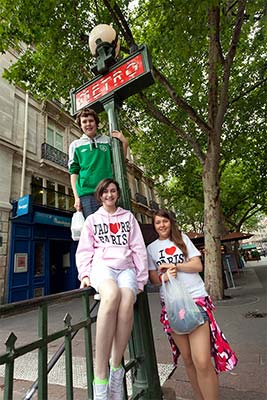
MONEY, SAFETY, AND STAYING CONNECTED
Top Kids’ Activities and Sights
Paris works well with children—smart parents enjoy the “fine art” of simply experiencing Paris’ great neighborhoods, parks, and monuments while watching their kids revel in the City of Light. After enjoying the city’s most family-friendly sights, your children may want to return to Paris before you do.
Involve your kids in trip planning. Have them read about the places that you may include in your itinerary (even the hotels you’re considering), and let them help with your decisions.
• Choose hotels in a kid-friendly area near a park. The Rue Cler and Luxembourg neighborhoods are both good.
• If you’re staying more than a few days, think about renting an apartment (for tips, see the “Sleeping” section in the Practicalities chapter).
• If traveling with infants, plan on bringing or buying a light stroller (poussette) for neighborhood walks and a child backpack (porte bébé) for riding the Métro. Strollers usually work fine on the bus (enter through buses’ larger central doors, then park the stroller in the designated poussette area...if there’s room), but they’re tough in the Métro (miles of stairs). Many sights allow either strollers or backpacks, but usually not both (some museums that don’t allow backpacks may provide strollers).

• Bring your own drawing supplies and English-language books; they’re harder to find and pricey in Paris. If you run out, visit one of the English-language bookstores listed on here.
• If your kids love peanut butter, bring it from home (it’s harder to find in France).
Try these tips to keep your kids content throughout the day.
• Kid-friendly foods that are commonly available and easy to order include crêpes (available at many takeout stands), croque monsieurs (grilled ham-and-cheese sandwiches), and tartines (open-faced sandwiches). Common meaty choices include hamburgers, saucisse (skinny grilled sausages), or steak haché (a burger without the bun or toppings). Plain pasta is available at many cafés and some bistros (ask for pâtes au beurre). Carry a baguette to snack on.

• For breakfast, try a pain au chocolat (chocolate-filled pastry) or dip your baguette in a chocolat chaud (hot chocolate). Fruit, cereals, and yogurt are usually available.
• Help you kids acquire a taste for Nutella (chocolate and hazelnut spread), available everywhere. Look for organic (bio) stores, where you can find numerous nut butters and Chocolade, a less-sugary version of Nutella.
• For older kids, be aware that the drinking age is 18 in France. Your server may assume that your teen will have wine with you at dinner. Teens are also welcome in most bars and lounges (there’s no 21-and-older section).
• Eat dinner early, before the sophisticated Parisian crowd dines (aim for sitting down by 19:00 at restaurants—earlier at cafés and places that serve food continually).
• Skip romantic places. Look for cafés (or fast-food restaurants) where kids can move around without bothering others.
• Picnics work well. Boulangeries are good places to grab off-hour snacks when restaurants aren’t serving. (For picnic tips, see the “Eating” section in the Practicalities chapter.)
The key to a successful Paris family vacation is to slow down. Tackle one or two key sights each day, mix in a healthy dose of pure fun at a park or square, and take extended breaks when needed.
• Involve your children in the trip. Let them help choose daily activities, lead you through the Métro, and so on.
• Older kids and teens can help plan the details of a museum visit, such as what to see, how to get there, and ticketing details.
• To minimize unnecessary travel, try to match kid activities with areas where you’ll be sightseeing (for example, the Louvre is near the kid-friendly Palais Royal’s courtyards and Tuileries Garden). Additional kid-friendly sights are located within Paris’ parks; see “Parks and Gardens,” later.
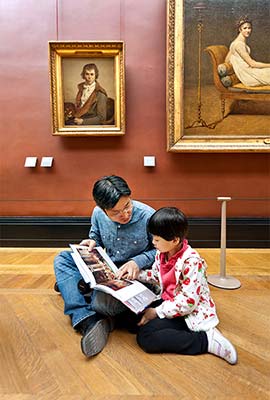
• For information on children’s activities, including shows, museums, and park events, look in L’Officiel des Spectacles magazine under “Jeunes” (see here).
• Limit museum visits to 45 minutes—period! Kids will tolerate a little culture if it’s short and focused, with plenty of breaks (for macarons, crêpes, glace, madeleines, etc.).
• Since many schools let out early on Wednesdays, expect parks and other children’s sights to be busy on Wednesday afternoons, and expect more kid activities at those sights.
• Follow this book’s crowd-beating tips. Book sights ahead when possible, or buy Museum Passes or skip-the-line tickets for adults (kids are usually free). Kids despise long lines even more than you do.
• Deputize your child to lead you on my self-guided walks and museum tours.
• Museum audioguides and apps usually work for older children, and some sights have audioguides designed for young travelers. You can also hit the gift shop first so kids can buy postcards and have a scavenger hunt to find the pictured artwork. When boredom sets in, try “I spy” games or have them count how many babies or dogs they can spot in all the paintings in the room.
• Bring a sketchbook to a museum and encourage kids to select a painting or statue to draw. It’s a great way for them to slow down and observe.
• Instead of hot, all-day sightseeing, mix in a nighttime stroll among the street performers on Paris’ pedestrian-friendly streets. See “Night Walks” in the Entertainment in Paris chapter for ideas.
• Kids love climbing to the summit of things—domes, towers, and viewpoints.
• Take a bike tour with the family (see “Biking,” later).
• Buy each of your children a trip journal where they can record observations, thoughts, and memories. This journal could end up being your child’s most cherished souvenir.
• For a group project, keep a family journal. Pack a small diary and a glue stick. While relaxing at a café over a citron-pressé (lemonade), take turns writing about the day’s events and include mementos such as colorful ticket stubs from museums, postcards, or stalks of lavender.
• Let kids pick out some toys and books. The best and cheapest toy selections are usually in department stores, like Galeries Lafayette. Note that Legos are sometimes different in Europe than in the US, and the French have wonderful doll clothes with a much wider selection than typically found in the US. Kids like the French adventure comics Astérix and Tintin (both available in English, sold in bigger bookstores with English sections).
• Learn and play boules, a form of outdoor bowling (see the sidebar on here). The best thing we did on one trip was to buy our own set of boules. We’d play before dinner, side by side with real players at the neighborhood park. Buy your boules de pétanque at a Decathlon sports store (www.decathlon.fr). The boules make great (if weighty) souvenirs and also provide entertainment (and memories) once you’re back home.
Before your trip gets underway, talk to your kids about safety and money.
• Give your child a money belt and an expanded allowance; you are on vacation, after all. Let your kids budget their funds by comparing and contrasting the dollar and euro.
• If you allow older kids to explore a museum or neighborhood on their own, be sure to establish a clear meeting time and place.
• Have a “what if” procedure in place in case something goes wrong. If your child has a mobile phone, enable the “Find My Phone” feature in case you get separated. Give your kids your hotel’s business card, your mobile phone number, and emergency taxi fare. Let them know to ask to use the phone at a hotel if they are lost. If they’re using their mobile phone, show them how to make calls in France (see the “Staying Connected” section in the Practicalities chapter).
• Readily available Wi-Fi (at hotels, some cafés, and all Starbucks and McDonald’s) makes bringing a mobile device worthwhile and keeps connection costs down. Check your phone plan to see what messaging it allows and consider a supplemental plan for the whole family if it’s needed. Adults can stay connected to teenagers while allowing them maximum independence, and teens can keep in touch with friends both old and new via the same apps they use at home. See the “Staying Connected” section in the Practicalities chapter for more information.
Kids 17 and under are free at all sights where the Museum Pass is accepted, such as the Arc de Triomphe, Louvre, Orsay, and Versailles. Note that at some sights (such as the Army Museum), Museum Pass holders must wait in line to pick up their free children’s tickets.
You could fill an entire kid-centric day here. Come early and ride the elevator up the tower before crowds appear, or ride it above the lights at night ( see the Eiffel Tower Tour chapter). The Champ de Mars park stretches out from the tower’s base, with picnic-perfect benches, sand pits, and other fun. Big toys are located at the nonriver end of the park (with your back to the tower, it’s to the far right). Puppet shows (www.guignolduchampdemars.fr), pony rides, and pedal go-carts may be available (usually after 11:00 Wed, Sat-Sun, and on all summer days; after 15:00 otherwise, Mo: Ecole Militaire, RER/Train-C: Champ de Mars-Tour Eiffel, or bus #69). A view café with good prices sits at the center of the park next to these kid-friendly activities.
see the Eiffel Tower Tour chapter). The Champ de Mars park stretches out from the tower’s base, with picnic-perfect benches, sand pits, and other fun. Big toys are located at the nonriver end of the park (with your back to the tower, it’s to the far right). Puppet shows (www.guignolduchampdemars.fr), pony rides, and pedal go-carts may be available (usually after 11:00 Wed, Sat-Sun, and on all summer days; after 15:00 otherwise, Mo: Ecole Militaire, RER/Train-C: Champ de Mars-Tour Eiffel, or bus #69). A view café with good prices sits at the center of the park next to these kid-friendly activities.
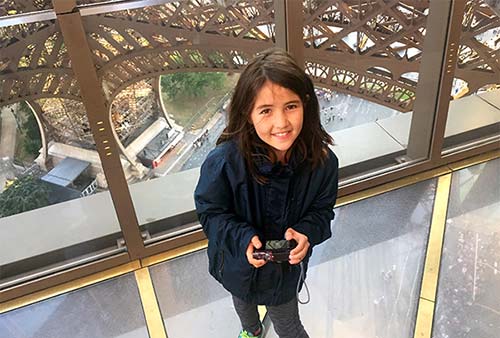
All ages enjoy the view from Place du Trocadéro, across the river from the Eiffel Tower, especially after dark (Mo: Trocadéro). The terrific National Maritime Museum (Musée National de la Marine) is docked at Trocadéro, with all things nautical, including wonderful ship models. The Aquarium de Paris in the gardens below the Trocadéro boasts thousands of sea creatures (minimal English posted, though staff stationed at various points can give info in English; from €15 for kids 12 and under, from €21 for ages 13 and up—best rates online; more expensive on weekends—daily 10:00-19:00, 5 Avenue Albert de Mun, Mo: Trocadéro, +33 1 40 69 23 23, www.aquariumdeparis.com).
Paris’ famous Gothic cathedral remains closed during ongoing restoration after the 2019 fire, though the reconstruction is fascinating to observe (best from the Left Bank side).  See the Historic Paris Walk chapter or
See the Historic Paris Walk chapter or  download my free audio tour. The Paris Archaeological Crypt on the square in front of Notre-Dame is quick and interesting (covered by Museum Pass). Kids can push buttons to highlight remains of Roman Paris and leave with a better understanding of how different civilizations build on top of each other. Many teens will enjoy the virtual reality experience at Espace Notre-Dame (behind the Archaeological Crypt, here). Or set them loose to explore the traffic-free lanes of the Latin Quarter across the river.
download my free audio tour. The Paris Archaeological Crypt on the square in front of Notre-Dame is quick and interesting (covered by Museum Pass). Kids can push buttons to highlight remains of Roman Paris and leave with a better understanding of how different civilizations build on top of each other. Many teens will enjoy the virtual reality experience at Espace Notre-Dame (behind the Archaeological Crypt, here). Or set them loose to explore the traffic-free lanes of the Latin Quarter across the river.
This area is popular with kids day and night. Mine couldn’t get enough of it. Hike up to the arch and watch the traffic rush around it, then stroll Avenue des Champs-Elysées with the river of humanity that flows along its broad sidewalks. Take your teenager to see a movie on the Champs-Elysées (“VO” next to the showtime means it’s shown in the original language).
 See the Champs-Elysées Walk chapter.
See the Champs-Elysées Walk chapter.
Teens like the Pompidou Center for its crazy outdoor entertainers, throngs of young people, happening cafés, and fun fountains next door (but it’s dead on Tue, when the museum is closed, and a multiyear renovation starting in 2025 may affect the outdoor attractions too). When the museum is open, the temporary exhibits and gift shop on the main floor are visually impressive. The museum’s wild collection of art (particularly the art installations) will make kids smile. The free escalator to the top is a good ride with great views for all ages.
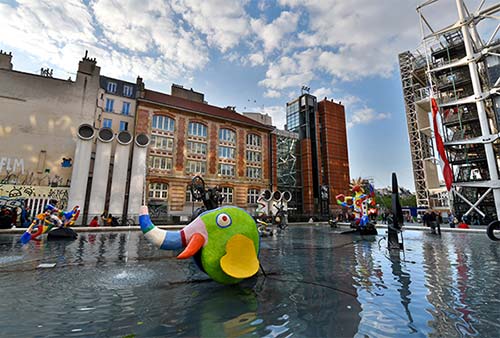
 See the Pompidou Center Tour chapter.
See the Pompidou Center Tour chapter.
The Paris Zoo is spectacular, re-creating habitats from five continents for both beasts and visitors to enjoy. Visit the modern glass greenhouse and walk among colorful birds, jumping monkeys, and other furry tree dwellers. Combining time at the zoo with a picnic lunch (pick up elsewhere) in the Bois de Vincennes park (with paddleboats, pony rides, and chateau tours) is a delightful way to spend the day.
Cost and Hours: €15 for kids 3-11, €20 for ages 12 and up, free for ages 2 and under; Mon-Fri 9:30-18:00, Sat-Sun until 19:30, Nov-March 10:00-17:00 and closed Tue; tram line 3 or Mo: line 8 to Porte Dorée station, then 10-minute walk—head toward the skyscraper-sized rock at edge of Bois de Vincennes; bus #46 or #86 brings you closer, +33 08 11 22 41 22, https://www.parczoologiquedeparis.fr.
For budding artistes, a trip here is a must. This small museum near the Louvre, designed with the youngest of art lovers in mind, offers contemporary art exhibits, a colorful bookstore, and workshops where kids can make their own art. Workshops are offered only in French—but the smiling, paint-covered kids don’t seem to mind, and there are plenty of kind, English-speaking staff to help.
Cost and Hours: €7.50, free for kids under age 3, daily 10:00-19:00; €22-31 for one-hour workshops, price includes entry; offered daily July-Aug, Wed and Sat-Sun only during school year; parents must stay with kids ages 2.5-4.5 but can leave kids ages 5-12; book online, by phone, or stop by; 23 Rue de L’Arbre-Sec, Mo: Louvre-Rivoli, Pont Neuf, Les Halles, or Châtelet; +33 1 40 67 97 66, http://museeenherbe.com.
This massive conglomeration of palaces, gardens, fountains, and forest can be brutal—or a good family getaway if well planned. Sundays, Tuesdays, and Saturdays are crazy busy, but the fountains are fun to experience. Strollers are allowed in the gardens, but not inside the palace (you’ll have to check it). Rent a bike and let the kids go wild on park paths (bikes of all sizes are available, even toddler bikes with training wheels). Or explore the gardens in a rented golf cart—while pricey, it’s great fun and easy. (For liability reasons, the staff wants only parents to do the driving, but once away from the palace...) Or you can row row row a boat on the Grand Canal or attend an equestrian performance at Versailles’ stables. The Domaine de Marie-Antoinette (opens at noon) has trails for scampering on, and her Hamlet has barnyard animals up close and personal.
 See the Versailles chapter or
See the Versailles chapter or  download my free audio tour.
download my free audio tour.
Paris’ public parks are perhaps your single best source of kid-friendly fun. Besides providing an outlet for high-energy kids (and a chance for the whole family to take a sightseeing breather), Parisian parks host a variety of activities, many of them with a quintessentially French flair.
Marionette shows, called guignols (geen-yohl), can be interesting for children patient enough to sit still. Shows are in French but have fairly easy-to-follow plots and some internationally understood slapstick (look for them in bigger parks, such as Luxembourg Garden, and check L’Officiel des Spectacles, under “marionnettes,” for times and places). The game of boules is played in most parks.
Temporary amusement parks come to life in public parks throughout the city; the Ferris wheel pops up in summer in the Tuileries Garden, and the rides in the Tuileries are the best—my daughter preferred them to Disneyland Paris.
You can rent toy boats to sail on a park’s pond, or rent real rowboats at bigger parks, such as in Versailles’ gardens (along the Grand Canal) or in the huge Bois de Vincennes (Mo: Porte Dorée). Bigger parks can be perfect for a relaxing bike ride. Pony rides are offered on certain days in some parks, such as Luxembourg Garden and the Bois de Boulogne; to learn when and where the ponies are trotting, check https://animaponey.com or call +33 6 07 32 53 95.
This is my favorite place to mix kid business with pleasure. This perfectly Parisian park has it all—from tennis courts to cafés—as well as a big-toys play area with imaginative slides, swings, jungle gyms, rope towers, and chess games (see “Luxembourg Garden” map on here). To find the big-toys play area, head to the southwest corner (small fee, entry good all day, many parents watch from chairs outside the play area, open daily, usually 10:00-19:00 in summer, until 16:00 in winter, pay WC nearby). Kids also like the speedy merry-go-round (small fee), the pony rides, and the toy sailboats for rent in the main pond (activities open daily in summer, otherwise Wed and Sat-Sun only). Near the main building is a toddler wading pool (summer only) and sand pit (both free). A puppet theater hosts guignol shows (in French), located in the southwest corner of the park near the children’s play area (€7.20; shows year-round Sat-Sun at 11:00 and also Sat-Sun and Wed at 15:15 and 16:30—times may vary by season, 1-2 shows daily during school breaks and for most of July-Aug, check schedule online; 45 minutes, no air-con, +33 1 43 26 46 47, www.marionnettesduluxembourg.fr). The park has many shaded paths as well as big, open areas perfect for kicking a ball. Kids can even play in the grass opposite the palace (Mo: St-Sulpice, Odéon, or Notre-Dame-des-Champs).
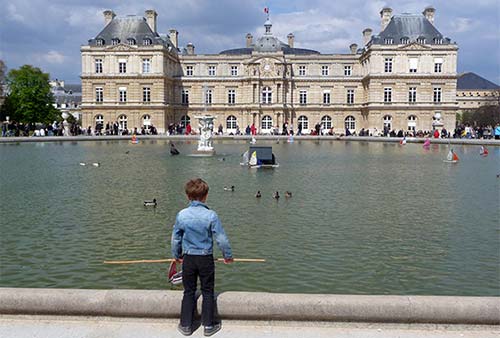
This central park, located between the Louvre and Place de la Concorde, across the river from the Musée d’Orsay, comes in handy for kid breaks. You’ll find fun trampolines in the northwest corner of the park near the Place de la Concorde Métro stop (ages 2-12 only, daily 11:00-19:00). Nearby is a play area with rope towers and slides and an old-fashioned merry-go-round. The Tuileries Garden also hosts a summer fair with rides, games, and a grand Ferris wheel.
These one-time expressways-turned-riverfront parks—running from Pont de l’Alma (near the Eiffel Tower) to the Orsay Museum on the Left Bank, and from the Louvre to Place de la Bastille on the Right Bank—are a joy for families, with kid activities such as climbing walls, pétanque courts, and big chess sets, plus good eating options. It’s also tailor-made for bike rides away from traffic (for details, see here).
Gardeners, botanists, natural scientists, and troops of kids love this place. Located on the Left Bank southeast of the Latin Quarter, the park is short on grass and English information but long on kid activities, including several play areas and some kid-friendly natural-science museums. There’s also a zoo, but it has just a few animals in old cages. From the park entrance near the river on Place Valhubert, you’ll find several museums lining the left side of the park (Mo: Gare d’Austerlitz, Censier-Daubenton, or Jussieu).
The sights are described in the order in which you’ll pass them when coming from the riverside entrance. An information office is located in the small house at the riverside entrance to the park (www.jardindesplantesdeparis.fr).
At the Galerie de Paléontologie, kids gaze into the eyes of dinosaurs and huge animal skeletons. There are no English explanations, but they’re not really needed (free for ages 25 and under, €10 for adults, not covered by Museum Pass, Wed-Mon 10:00-18:00, closed Tue, busiest on weekends, entrance faces river next to McDonald’s, +33 1 40 79 56 01).
The Ménagerie des Jardin des Plantes, a modest little zoo on the park’s opposite side, displays live animals—although the population here is old and a bit sleepy (€10 for kids 4-25, free for kids 3 and under, €13 for adults, daily 9:00-18:00, +33 1 40 79 37 94).
The Galerie de Minéralogie is made for fans of stuff that comes from the earth. Your kids may dig the collection of rocks, big crystals, and more, but there’s nary a shard of English (€5 for ages 25 and under, €7 for adults, Wed-Mon 10:00-18:00, closed Tue, +33 1 40 79 56 01).
The Grande Galerie de l’Evolution, at the nonriver end of the park, is an impressive Night at the Museum kind of place focused on the evolution of animals. With an open floor plan and high ceilings, it features giant whale skeletons, tons of dead bugs under glass, all sorts of taxidermied animals, and many other kid-cool exhibits. Pick up the map and look for the good English explanations inserted into wood benches throughout the gallery (free for ages 25 and under, €10 for adults, €13 with special exhibits, not covered by Museum Pass, book timed-entry ticket online in advance to ensure entry; open Wed-Mon 10:00-18:00, closed Tue, busiest on weekends and Wed; gift shop sells a helpful book about the collection in English, +33 1 40 79 30 00, www.mnhn.fr). You can pay extra to visit the Galerie des Enfants du Muséum, a fun series of exhibits within the Galerie de l’Evolution. It’s stuffed with animal-centric interactive displays and activities designed for 6- to 12-year-olds, all in English. Consider booking a time slot online a few days ahead (may be closed for renovation in 2024; €10 for ages 4-25, free for kids 3 and under, €13 for adults, same hours as Grande Galerie, last entry one hour before closing, +33 1 40 79 54 79, www.galeriedesenfants.fr).
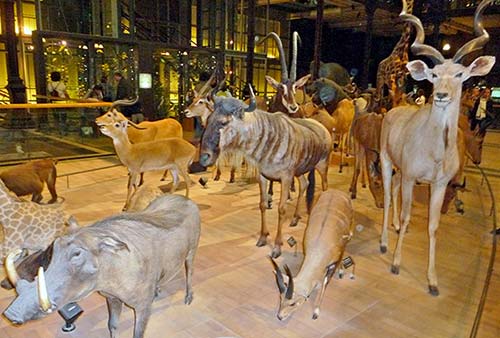
This vast area of modern parks and museums is designed to encourage all ages to interact with nature, art, and technology. It’s Europe’s largest science park, with outdoor concerts and movies, a playground great for summer visits, and grass you’re allowed to run around on. The main attractions for kids are Europe’s largest science museum (Cité des Sciences et de l’Industrie), a 360-degree movie theater (Planétarium), a real French submarine, acres of parks, play areas including the Garden of the Dragon (a huge steel dragon with a really long slide), a working canal, and working windmills (download English guide, 211 Avenue Jean Jaurès, Mo: Porte de la Villette, follow Corentin-Cariou or Porte de Pantin signs, +33 1 40 03 75 75, www.villette.com).
Cité des Sciences et de l’Industrie: For families, the best part of this big science-museum complex is Cité des Enfants, a fun place that’s perfect for simultaneously teaching and exhausting younger children. Kids can climb inside a living ant farm, operate a crane (safety vest and hard hat provided), create whirlpools in the water exhibit, step into a tornado, film themselves driving down the highway in front of a green screen, and much more. Tickets are sold for a specific 1.5-hour time slot, and for one of two sections of the museum: the area designed for ages 2-7, or the one designed for ages 5-12 (€10 for kids, €13 for adults; starting at 9:30, 11:30, 13:30, and 15:30—verify times on website; closed Mon; English info posted for kid exhibits 5-12, www.cite-sciences.fr [URL inactive]). There is a good café with healthy options on the ground floor, an indoor picnic space, and a bookshop to keep you busy while you wait for your entrance time.
At the more teen-oriented permanent Expositions, you can explore a real submarine, take a trip through the human body, see a 360-degree movie in the Planétarium, travel from earth to the extragalactic void to learn how matter, light, and energy are connected, and much more (free downloadable apps in English). This area is likely to appeal more to hard-core science fans and teenagers on the honor roll (€13 for adults, €10 for ages 6-25, €3 for ages 5 and under, free for ages 2 and under, deals if you combine with other sights/activities, Tue-Sat 10:00-18:00, Sun until 19:00, closed Mon, no specific entrance time required).
This fun-filled, steampunk-themed park delivers a brilliant kids’ day with multiple playgrounds, an apiary, a small zoo, and a spray park (€7 entry). You can buy separate tickets for the more elaborate rides and activities (€3 each, €29 day passes available). Kids can play independently while parents lounge on the comfy chairs, and there are good food options. Crowds grow in afternoons and on weekends (daily 11:00-18:00, Wed and Sat-Sun from 10:00, in the Bois de Boulogne, Mo: Les Sablons, then follow Rue de l’Orléans to the entrance, +33 1 40 67 90 85, www.jardindacclimatation.fr).
Take your kids out for a bike ride (see here for a suggested route). If the city’s streets seem too intimidating, consider heading to one of the parks outside the city center (such as the gardens of Versailles)—many of them are great for biking, and even offer rentals.
Bike About Tours has good information and rentals (baby seats, tandem attachments, kids’ bikes). They also offer fun private family tours of Paris (see here for prices and contact information).
Sunday afternoons are fun for rollerblading with locals at your own pace, starting at the south side of Place de la Bastille at 14:30 (see here, www.rollers-coquillages.org; skate shop nearby is closed Sun but has weekend rentals).
A variety of companies offer one-hour Seine cruises on huge glass-domed boats. Or hop on a Batobus, a river bus connecting eight stops along the river: Eiffel Tower, Orsay Museum, St. Germain-des-Prés, Notre-Dame, Jardin des Plantes, Hôtel de Ville, the Louvre, and Pont Alexandre III—near the Champs-Elysées. Longer boat trips ply the tranquil waters of a peaceful canal between the Orsay and Bassin de la Villette (see here).
The hop-on, hop-off double-decker bus tours (see here) are a good way to begin your visit. Taking a nighttime tour in a convertible Deux Chevaux is a terrific way to end your trip (here).
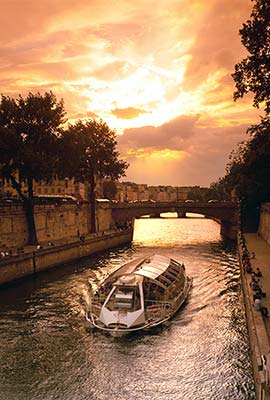
Paris has more than three dozen swimming pools. Ask your hotelier for the location of the nearest pool or head for one of the places listed next. Note that boys and men are required to wear Speedo-style (tight) swimsuits at pools (oh là là!), and most public pools require everyone to wear a swim cap (bring one with you, or find them at a Monoprix or Decathlon sporting-goods store).
Aquaboulevard: Paris’ huge pool/waterslide/miniature golf complex is easy to reach and a complete escape from the museum scene. Indoor and outdoor pools with high-flying slides, waves, geysers, wakeboards, and whirlpool tubs draw kids of all ages. It’s pricey (and steamy inside), but a good opportunity to see soaked Parisians at play (a day pass is €22 for kids 3-11, €39 for adults, cheaper rates for more than one visit, no children under 3, daily 9:00-23:00, English-speaking staff, keep spare change for lockers, men’s swimsuits and swim caps are affordable at the Decathlon store right there, +33 1 40 60 10 00, www.aquaboulevard.fr). Ride the Métro to the end of line 8 (Balard stop), walk two blocks under the elevated freeway, veer left across the traffic circle, and find Aquaboulevard in a complex of theaters and shops.
Joséphine Baker Pool: Housed in a giant barge docked along the Seine, this state-of-the-art floating swimming pool (Piscine Joséphine Baker) boasts generous wood decks and views of the city that get even better (though the pool gets more crowded) on sunny days, when the retractable rooftop is opened up (€7 for 2 hours, less for kids and in winter, generally open Mon-Fri 7:00-8:30 & 13:00-20:00 or 22:00, Sat-Sun 11:00-19:00, opens earlier in summer, cabana-type cafés next door, near Gare d’Austerlitz at 8 Quai François Mauriac, Mo: Quai de la Gare or François Mitterrand, +33 1 56 61 96 50, www.piscine-baker.fr).
Europe’s Disneyland is a remake of California’s, with most of the same rides and smiles with a Franco-international vibe. Here, Mickey Mouse speaks French, and you can buy wine with your lunch. My kids went ducky for it. It’s fun to experience a European take on a very American creation.
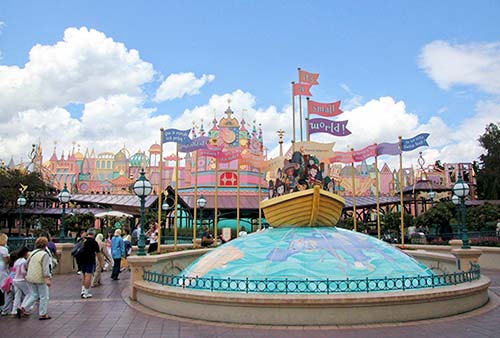
The Disneyland Paris Resort is a sprawling complex housing two theme parks (Disneyland Paris and Walt Disney Studios), a few entertainment venues, and several hotels. Opened in 1992, it was the second Disney resort built outside the US (Tokyo was first) and it attracts millions of visitors each year.
Disneyland Paris: This park has cornered the fun market, with classic rides and Disney characters. You’ll find familiar favorites wrapped in French packaging, like Sleeping Beauty Castle (Le Château de La Belle au Bois Dormant) and Pirates of the Caribbean (Pirates des Caraïbes).
Walt Disney Studios: This zone has a Hollywood focus with animation, special effects, and movie magic “rides,” featuring Pixar and Marvel movies with well-known characters. The Marvel Avengers Campus allows guests to test their courage alongside their favorite superheroes. You can also blast off into space with Buzz Lightyear in an intergalactic laser-shooting gallery. Gentler attractions include a re-creation of the parachute jump in Toy Story and a Finding Nemo-themed ride (Crush’s Coaster) that whisks you through the ocean current.
Disneyland is easy to get to and may be worth a day—if Paris is handier than Florida or California.
By Bus or Train from Downtown Paris: The slick 45-minute RER/Train-A trip is the best way to get to Disneyland from Paris. Take RER/Train-A to Marne-la-Vallée-Chessy (check the signs over the platform to be sure Marne-la-Vallée-Chessy is served). Catch it from one of these stations: Charles de Gaulle-Etoile, Auber, Châtelet-Les Halles, or Gare de Lyon (at least 3/hour, drops you 45 minutes later right in the park, about €10 each way). The last train back to Paris leaves shortly after midnight. When returning, remember to use the same RER/Train-A ticket for your Métro connection in Paris.
You’ll need to buy a Navigo Découverte pass or Navigo Easy card covering Zones 1-5 (which covers your Paris Métro rides for the day and the round-trip train to Disneyland; about €18 for Zones 1-5 ticket.
Disneyland Express runs buses from several stops in central Paris (including Opéra, Châtelet, Eiffel Tower, and Gare du Nord). Figure around €55 round-trip per person (morning departures from Paris between 8:00 and 9:00; book tickets online, www.disneylandparis.com).
By Bus or Train from the Airport: Both of Paris’ major airports (Charles de Gaulle and Orly) have direct shuttle buses to Disneyland Paris. Fast TGV InOui trains run from Charles de Gaulle to near Disneyland. For details on these options, see here (for Charles de Gaulle) and here (for Orly).
By Car: Disneyland is about 40 minutes (20 miles) east of Paris on the A-4 autoroute (direction Nancy/Metz, exit #14). Parking is about €30/day at the park.
Cost: A variety of single and multiday tickets and packages (including transportation, lodging, and/or meals) are sold for Disneyland Paris and/or Walt Disney Studios. Regular prices (about €135 for adults) are discounted about 25 percent Nov-March, and promotions are offered occasionally (check their website).
Hours: Disneyland—daily 10:00-22:00, mid-May-Aug until 23:00, until 20:00 in winter, open later on weekends, hours fluctuate with the seasons (check website for precise times). Walt Disney Studios—daily 10:00-19:00.
Skipping Lines: The Premier Access system allows park-goers to skip the lines for the most popular rides by paying a fee that varies by date and attraction (see website for details). You’ll also save time by buying park tickets in advance (at airport TIs, some Métro stations, or along the Champs-Elysées at the Disney Store).
Avoiding Crowds: Saturday, Sunday, Wednesday, public holidays, and any day in July and August are the most crowded. After dinner, crowds tend to clear out.
Information: Disney brochures are in most Paris hotels. For more info and to make reservations, call +33 1 60 30 60 53, or try www.disneylandparis.com.
Eating with Mickey: Food is fun and not outrageously priced. (Still, many smuggle in a picnic.)
Most are better off sleeping in the real world (i.e., Paris), though with direct buses and freeways to both airports, Disneyland makes a convenient first- or last-night stop. Seven different Disney-owned hotels offer accommodations at or near the park in all price ranges. Prices are impossible to pin down, as they vary by season and by the package deal you choose (deals that include park entry are usually a better value, with more in the $$$$ range). To reserve any Disneyland hotel, call +33 1 60 30 60 53, or check www.disneylandparis.com. The prices you’ll be quoted include entry to the park. Hotel Cheyenne** and Hotel Santa Fe** offer fair midrange values, with frequent shuttle service to the park (or a 20-minute walk). Another option is Davy Crockett’s Ranch Hotel, but you’ll need a car to stay there. The most expensive is the Disneyland Hotel,**** right at the park entry, about three times the price of the Santa Fe. The Hotel Dream Castle **** is another higher-end choice, with nearly 400 rooms done up to look like a lavish 17th-century palace. You’ll see more options on the Disney website.